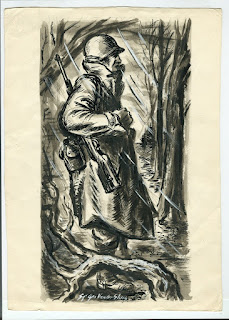Sometimes you stumble across something, be it art, an invention, something in nature or a story... and it burns inside you from that moment on wanting to be shared. I had just such an occurrence this week when I decided to kill a little time with something educational from my Netflix list. Enter Rick Beyer's 2013 PBS documentary, The Ghost Army.
This video is a clip from the documentary
There are really two fascinating stories here: the death defying cat-and-mouse game of deception and the artwork that immortalized it.
The Artists' War
 During WWII, a special unit comprised of artists was put together to camoflague bases on the East Coast for fear of German planes raining blitzkrieg on American soil. These men were chosen by application only.
During WWII, a special unit comprised of artists was put together to camoflague bases on the East Coast for fear of German planes raining blitzkrieg on American soil. These men were chosen by application only.
In 1944 this special unit was reassigned to the battlefields with new orders: staging a fake army. While this subterfuge is a genius move in the time before drone surveillance it did present one real problem- a FAKE army is a REAL target.
How would a company of 1000 men create a realistic enough decoy to fool Nazi intelligence? If you guessed inflatable tanks you'd be right. Well, mostly right. A combination of inflatable machines, sound trucks and fake radio transmissions were used and intended to be intercepted. There were three units- the play actors staging the scene, the sound guys and the radio detail.
Setting the Stage
These men had to not only set up hundreds of tanks, trucks, jeeps canons, etc., but they had to make it look real- they couldn't be obvious. That meant camouflaging their FAKE machines, occupying towns and talking the talk. At 20 different staging sites between Normandy and the Rhine, they strategically placed ordinance, made tire tracks and set up mannequins. They took turns pretending to be ranking officers and set up phony headquarters- camouflaged in plain site- out in the open meant to be seen, while giving the illusion of the contrary.
The Noise
Stateside, before deployment, hours and hours and reels upon reels of "military noise" was recorded. The sounds of trucks driving, men yelling, bridges being built and whatever else they could think of were recorded. These sounds were blasted from massive sound trucks for hours in the middle of the night to give the illusion of troops on the move.
Video clip of "sonic deception"
A radio division was trained in code and given scripts to seamlessly take the place of the actual radio transactions going across the airwaves, monitored by the enemy.
And it worked. The 23rd- the Ghost Army, a band of artists, managed to trick the Nazis and offer vital ground support with minimal numbers and tons of ingenuity.
Gallery
The artists of the 23rd often took time while stationed at various posts to capture the scenes of war. These pieces tell the story of the Ghost Army.
 |
| Watercolor of resting soldiers by John Jarvie |
 |
| Sketch, Arthur Shilstone |
 |
| Watercolor, by Arthur Singer |
 |
| Arthur Shilstone |




 |
| by George Vander Sluis |
Many other young artists of the time captured the grit and chaos of the war from the other side of the world. Here are some links to other moving pieces, not related to the Ghost Army.
For stories from the men themselves, visit the Ghost Army Website.












No comments:
Post a Comment